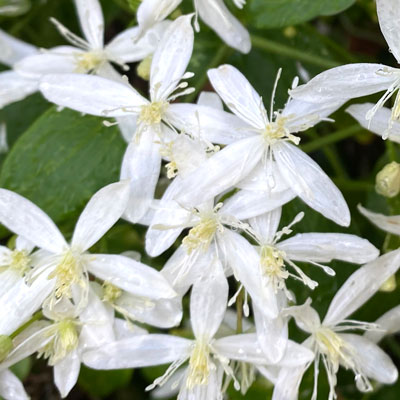Sweet Autumn Clematis: September 10, 2020

Having grown up in South Central Texas, I never really saw clematis bloom in the spring until I moved to Ohio to finish my undergraduate schooling. Then I could see what all the fuss was about.
When we moved back to Texas, I tried a couple of those northern varieties and they soon fried and fizzled in our heat. But then I found a type that seems to love Texas, and we love it right back.
Sweet autumn clematis is in bloom around Texas right now. The photos you are seeing are ones I took last weekend when Lynn and I ducked into McKinney to grab a Fletcher’s State Fair corny dog in the much-hyped special promotion. As we sat fine-dining in the car, I saw them across the street. I told her as soon as our feasting was finished, that I wanted to drive across the six lanes to see if my eyes were serving me properly.

Indeed, as I walked back into that quiet little alcove with moisture from a recent rain shower still on the leaves and flowers, the incredibly sweet aroma of the clematis blooms hung heavily in the air. It was wonderful.
What you need to know about sweet autumn to grow it…
• Sweet autumn clematis (Clematis terniflora – sometimes identified as C. paniculata).
• Grows well in morning sun and afternoon shade or in shade.
• Prefers moist, highly organic soil.
• Extremely strong-growing vine to 30 feet tall.

• Aggressive, will sprawl over shrubs, so prune to keep in bounds.
• Excellent over arbors and fences.
• Use where you’ll be able to enjoy the rich fragrance.
• Deciduous, so stems will be bare in winter.
• Therefore, prune back drastically each winter. Cut stems back to 18 to 24 inches to keep plants from becoming leggy.
• Self-sows and can become invasive in moist conditions of East Texas, so prune immediately after flowering has finished in fall to remove seed capsules.
• Propagated from seeds or by cuttings. Also available in Texas nurseries.
• Listed as “Invasive” in areas where there is enough moisture for it to self-sow and get started. Be forewarned if you’re in one of those parts of Texas (east and southeast).
